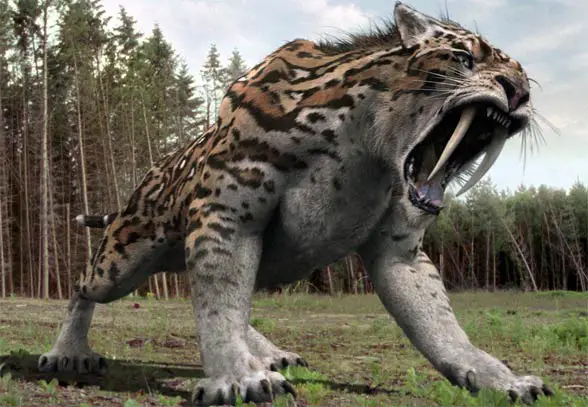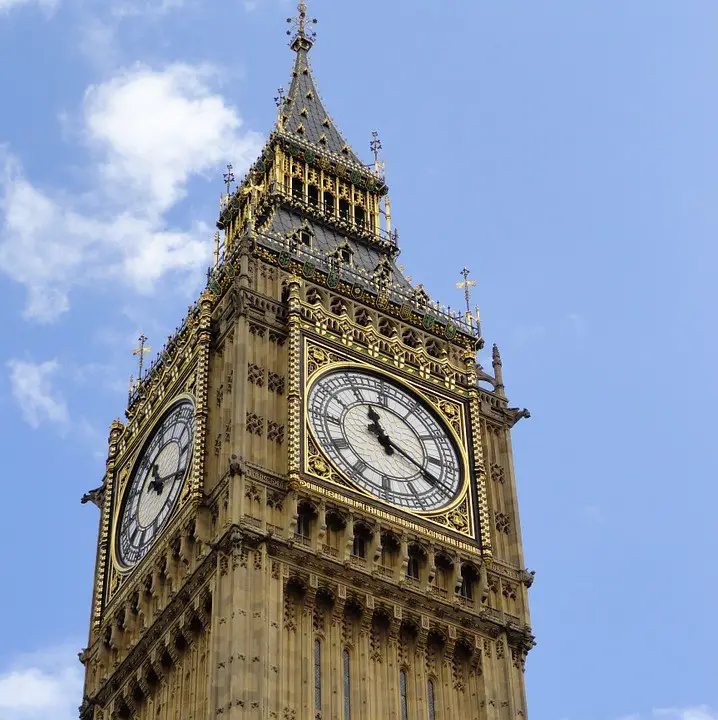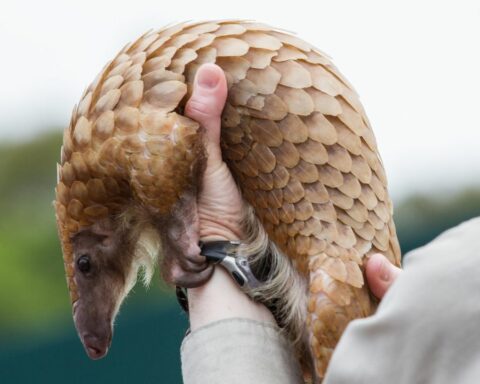Rhinoceros or Rhinos once inhabited Europe, Asia, and Africa. They have been drawn in cave paintings. Now they are only found in Africa’s savannahs and Asia’s tropical forests. They are known for their huge bodies, short but thick legs, and one or two horns above their nose. We have gathered a complete set of Rhino Facts For Kids that will help you in learning all about the Rhinoceros. You are going to learn about its scientific name, classification, species, evolution, appearance, physical features, physical abilities, diet, habitat, lifecycle, lifespan, reproduction, behavior, baby, adaptations, food chain, ecological role, population, endangerment, predators and many other Rhino Fun Facts.
Rhino Facts For Kids
What is a Rhino
- Rhino is a common abbreviation used for one of any five living species of Rhinoceros.
- Rhinoceroses or rhinos are odd-toed ungulates, which means hoofed animals that carry most of their body weight on one of the five or three toes, usually the third toe.
- The most distinguishing feature of rhinos is bearing a horn-like structure on the upper region of their snout.
- They are herbivores and some of the remaining largest mammals on the land.
- Three of their living species are native to Southern Asia, and two to Africa.
- Three species of the rhinoceros are listed as Critically Endangered on the IUCN Red List.
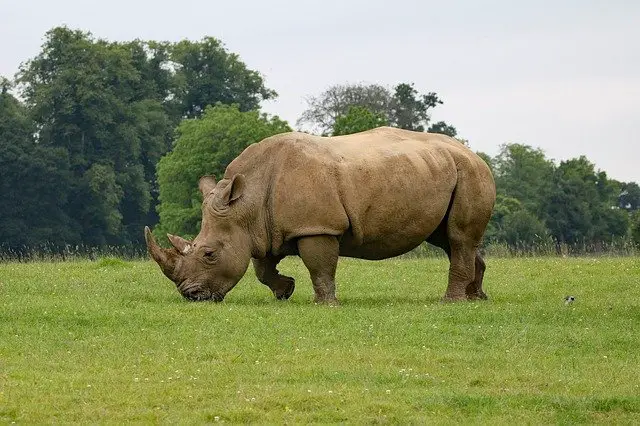
Scientific Name Of Rhinoceros
- Scientific names of the five living (extant) species of rhinoceros are:
-
- Diceros bicornis (Black or hook-lipped rhinoceros)
- Ceratotherium simum (White or square-lipped rhinoceros)
- Dicerorhinus sumatrensis (Sumatran rhinoceros)
- Rhinoceros unicornis (Indian rhinoceros)
- Rhinoceros sondaicus (Javan rhinoceros)
Scientific Classification Of Rhinoceros
- The following is the scientific classification or taxonomy of rhinoceros:
| Kingdom | Animalia |
| Phylum | Chordata |
| Sub-phylum | Vertebrata |
| Class | Mammalia |
| Order | Perissodactyla |
| Superfamily | Rhinocerotoidea |
| Family | Rhinocerotidae |
| Genera | Ceratotherium (extant)
Dicerorhinus (extant) Diceros (extant) Rhinoceros (extant) Coelodonta (fossil) Stephanorhinus (fossil) Elasmotherium (fossil) |
Rhino Species
- There are five living species of rhinos and numerous extinct species. The following is the list of living species of Rhinoceros:
| S.No | Species | Description |
| 1 | White Rhinoceros (Ceratotherium simum) |
|
| 2 | Black Rhinoceros (Diceros bicornis) |
|
| 3 | Sumatran Rhinoceros (Dicerorhinus sumatrensis) |
|
| 4 | Indian Rhinoceros (Rhinoceros unicornis) |
|
| 5 | Javan Rhinoceros (Rhinoceros sondaicus) |
|
Evolution
- During the early Eocene, the superfamily Rhinocerotoidea diverged from other Perissodactyla. Fossils of extinct Perissodactyla mammal Hyrachyus eximus excavated in North America date back to that period. This ancestor was small and hornless that resembled a small horse or taper more than a rhino.
- The superfamily Rhinocerotoidea is a group of three families; Hyracodontidae, Amynodontidae, and Rhinocerotidae that evolved during the late Eocene.
- Hyracodontidae had adaptations for speed and resembled horses more than rhinos. They are also called running rhinos. They were distributed across Eurasia during the period of mid-Eocene to early Miocene.
- Amynodontidae is also called aquatic rhinos and resembled hippopotamus in ecology and appearance more than a rhino. They were distributed across Eurasia and North America during the period of late Eocene to early Oligocene.
- Rhinocerotidae is the family of all modern rhinos. It initially appeared in Eurasia during the late Eocene. Its earliest members were numerous (at least 26 genera) and small and lived in North America and Eurasia. During the middle Oligocene, an extinction wave wiped out most smaller species, however, some lineages survived. The distribution of modern rhinos is believed to have started during the Miocene from Asia. The lineages that contained the living rhino species diverged during the early Pliocene.
What Does Rhino Look Like
-
White Rhinoceros
-
- White rhinos have a massive body, a big elongated head with a distinctive broad mouth, and wide nostrils.
- They have square-shaped lips, which they use for grazing.
- They have two horn-like growths on their snout.
- The front horn is larger than the back horn and has an average length of 24 inches. In females, the length of the front horn sometimes reaches as much as 59 inches.
- The back of their neck has a distinguishable hump.
- Like other rhinos, they have four stumpy feet, each one has 3 toes.
- Their body color ranges from slate-grey to yellowish-brown.
-
Black Rhinoceros
-
- Black rhinos also have elongated heads with small skulls as compared to white rhinos.
- They have hook-shaped lips. Their upper lip is pointed and prehansil, which they use for grasping leaves and tree twigs.
- Black rhinos also have two horns on their snout, the front one larger and the back one smaller.
- Like other rhinos, they have thick layered skin which protects them from sharp grasses and thorns.
- Despite its name, the body color of a black rhino varies from brown to grey.
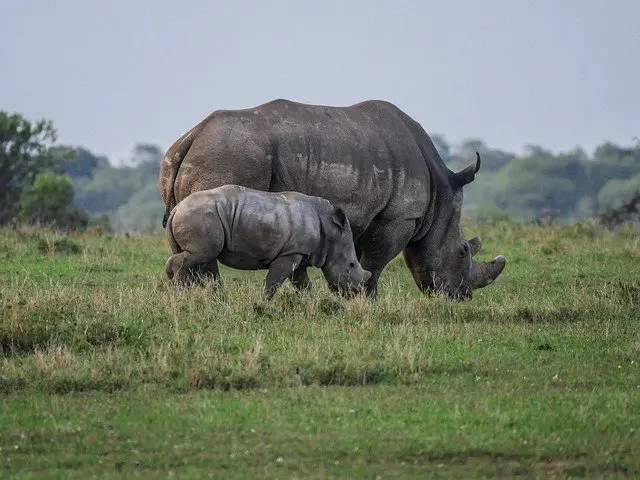
-
Sumatran Rhinoceros
-
- Sumatran rhinos also have two horns; the anterior or nasal horn is larger (5.9 to 9.8 inches long) while the posterior horn is much smaller (less than 3.9 inches in length).
- The color of the horns is black or dark grey. Males have larger horns than females.
- The body of Sumatran rhinos is mostly covered by a coat of reddish-brown hairs.
-
Indian Rhinoceros
-
- Indian rhinos have massive bodies and heavy skulls.
- They have thick skin of grey-brown color and skin folds of pinkish color.
- They have one horn on their snout.
- Wart-like bumps cover their shoulders and upper legs.
- Besides eyelashes, ear fringes, and tail brushes, very little hair exists on their body.
-
Javan Rhinoceros
-
- Javan rhinos have a single horn like that of Indian rhinos.
- Their horn is the smallest of all the living rhinos and is usually less than 7.9 inches long.
- Only male individuals have horns, while the females have only a small bump of 1 to 2 inches in length.
- Like Black and Sumatran rhinos, the Javan rhino is also a browsing rhino and has a pointed long upper lip.
- They have splotchy grey or grey-brown color skin.
- Their skin falls in folds at the back, shoulder, and rump regions.
Physical Features of Rhinoceros
- The physical features of all the rhino species are shown in the following table:
| S.No | Species | Height (feet) | Length | Weight |
| 1 | White Rhinoceros | 5.58 to 6.10 (males)
5.25 to 5.81 (females) |
3.7 to 4 meters (12.1 to 13.1 feet) for males
3.4 to 3.65 meters (11.2 to 12.0 feet) for females |
About 2,300 kg (5,070 lbs) for males
About 1,700 kg (3,750 lbs) for females |
| 2 | Black Rhinoceros | 4.6 to 5.9 | 3 to 3.75 meters (9.8 to 12.3 feet) | 800 to 1,400 kg (1,760 to 3,090 lbs) |
| 3 | Sumatran Rhinoceros | 3.94 to 4.76 | About 2.5 meters (8.2 feet) | 500 to 800 kg (1,102 to 1,763 lbs) |
| 4 | Indian Rhinoceros | 5.58 to 6.10 (males)
4.86 to 5.68 (females) |
About 3.6 to 3.8 meter (12.07 to 12.47 feet) for males
About 3.1 to 3.4 meter (10.2 to 11.2 feet) for females |
About 2,200 kg (4,850 lbs) for males
About 1,600 kg (3,530 lbs) for females |
| 5 | Javan Rhinoceros | 1.4 to 1.7 | 2 to 4 meters (6.5 to 13 feet) | Between 900 and 2,300 kg (1,980 to 5,070 lbs) |
Physical Abilities of Rhinoceros
-
Speed
-
- Rhinos can run at the speed of 40 to 50 km/h.
-
Jump
-
- While running, rhinos can go about 4 feet off the ground.
-
Swim
-
- According to the San Diego Zoo, the three Asian species of rhinos are excellent swimmers.
What do Rhinos Eat
- All species of rhinos are herbivores and eat only plant matter.
- All the rhino species eat different types of vegetation that depend on their habitat and the shape of their mouth.
- White and Indian rhinos have square-shaped mouths and are grazing species. They mostly eat grasses but also eat leaves, shrubs, tree branches, and fruits. They will drink water two times a day if available.
- Black, Sumatran, and Javan rhinos have pointed mouths with a prehensile upper lip and are browsing species. They eat leafy plants, shoots, branches, thorny bushes, and fruits.
- Salt licks are an important part of rhino nutrition. They drink salty water from small hot springs or seepages. However, not all rhinos are observed salt licking and most of them fulfill their requirement by eating mineral-rich plants.

How much Rhinos eat per day
- Rhinos eat an estimated amount of 50 to 54 kg of food per day.
What does baby Rhino eat?
- Baby rhinos feed only on the mother milk for the initial days of their lives.
- They eat mother milk for 18 months but meantime they also start eating plants.
Where do Rhinos Live – Rhino Habitat
-
Natural Habitat
-
- The natural habitat of rhinos include grasslands, floodplains, swampy regions, rainforests, and cloud forests.
- They usually live close to the water.
- They spend most of their time eating and sleeping only during the hottest part of the day.
- They enjoy wallowing in the mud or muddy water. Mud soaks protect them from biting insects and bugs and also act as a natural sunblock for them.

-
Biome
-
- The biomes in which rhinos live include savannah, open plains, dry forests, rainforests, and grasslands.
-
Range
-
- The habitat range of white and black rhinos in southern and eastern Africa.
- Sumatran rhinos are found in the Sumatra and Borneo islands of Indonesia.
- Javan rhinos are found only in the Ujung Kulon National Park of Java Island, Indonesia.
- The current range of Indian rhinos is in southern Nepal, northern West Bengal, and the Brahmaputra Valley.
-
Countries List
- White rhinos are found in:
- South Africa
- Namibia
- Zimbabwe
- Kenya
- Uganda
- Southern Chad
- Southwestern Sudan
- The Democratic Republic of Congo.
- Black rhinos are found in:
- Angola
- Botswana
- Kenya
- Malawi
- Mozambique
- South Africa
- Namibia
- Tanzania
- Eswatini
- Zimbabwe
- Zambia
- Sumatran and Javan rhinos are found in Indonesia.
- Indian rhinos are found in:
- India
- Nepal
- Bhutan.
- White rhinos are found in:
Rhino Life Cycle
- The life cycle of a rhino starts when it is born after a gestation period of about 16 months.
- The female reaches sexual maturity at the age of 4 to 6 years.
- They start mating at the age of about 6 years.
- Most species live for an average age of 40 years.
Rhino Lifespan
- The average lifespan of rhinos in the wild is 40 to 45 years.
- White rhinos live for up to 40 to 50 years.
- The lifespan of Black rhinos is from 35 to 50 years.
- While Indian rhinos live for about 35 to 45 years.
- The lifespan of Javan rhinos is estimated at 30 to 45 years.
- The lifespan of Sumatran rhinos in the wild is also estimated as 30 to 45 years. A captive female in the London Zoo died at the age of 32 years and 8 months.
Rhino Reproduction
- All the rhino species have a very low reproductive rate because of their huge body size.
- The breeding females take an average interval of 2 to 4.5 years between the birth of calves.
- Females of most rhino species start breeding at the age of 6 to 7 years.
- Rhinos are solitary animals and come together only for mating.
- Male follow the female when she is receptive. The mating pair stay together for 5 to 20 days and then go on their way.
- The gestation period in rhinos is 15 to 16 months.
- The mother gives birth to only a single calf at a time.
- Mothers take care of the calves and they stay together for 2 to 3 years or more.
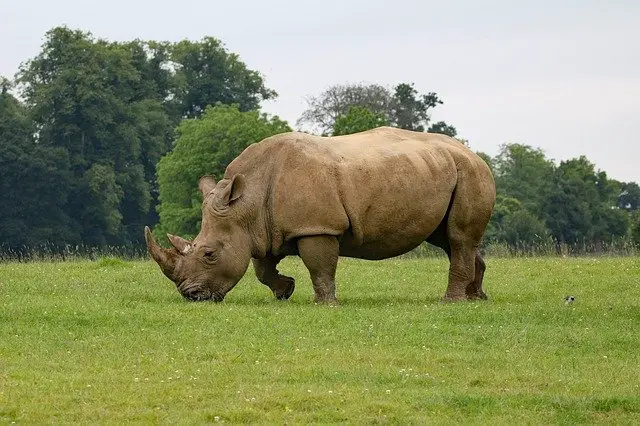
Rhinos Behavior
- All species of rhinos are solitary except females and their offspring. Individuals of each species usually avoid each other. Both males and females establish territories that may be crisscrossed. They mark the borders of their territories with urine and piles of dung. White rhinos live in groups of about 10 individuals (usually female and her offspring).
- Rhinos make several types of sounds. During courtship, white rhinos make snorts and grunts while squealing sounds represent their distress. When they feel threatened, they growl or make deep bellows.
- Rhinos usually prefer to avoid humans. But male individuals and females with calves may be aggressive and charged with little provocation.
- Sometimes, rhinos fight each other upon encounter. Black rhinos are especially more aggressive and fight each other. About 30% of females and 50% of male black rhinos die from fight-related injuries.
- Rhinos have a weak sense of sight and sometimes mistake rocks or trees as a threat and charge them.
- Rhinos enjoy wallowing in the mud. Mud coating on their body acts as a natural sunblock and bug repellent.
How Do Rhinos Protect Themselves
- When fighting, the two African species use the bigger of the two horns on their snouts as a weapon to defend themselves. They usually rub their horns on rough surfaces, so it is sharp enough to gore their thick skin and remove the outer soft layer.
- The three Asian species of rhinos do not use horns while fighting. They are equipped with razer-like sharp lower outer incisor teeth (also known as tusks), which they use as a weapon to protect themselves. In Indian rhinos, the length of such teeth reaches up to 5 inches (15 cm) in dominant males and causes lethal injuries on other males when they compete to access the breeding females. Such incisors are absent in African species.
Rhino Baby
- A baby rhino is known as a calf.
- At birth, a calf weighs from 40 to 65 kg.
- The calves resemble the adults and are unsteady for the first two to three days.
- For the first two months of their lives, they feed on the mother’s milk.
- They then also start eating vegetation along with suckling and are completely weaned at the age of 1 to 2 years.
- They stay with their mothers for 2 to 3 years. Female calves stay longer with their mothers even after the birth of other calves.
- Female rhinos of most species attain sexual maturity at the age of 5 to 7 years, while males at the age of 8 to 12 years.
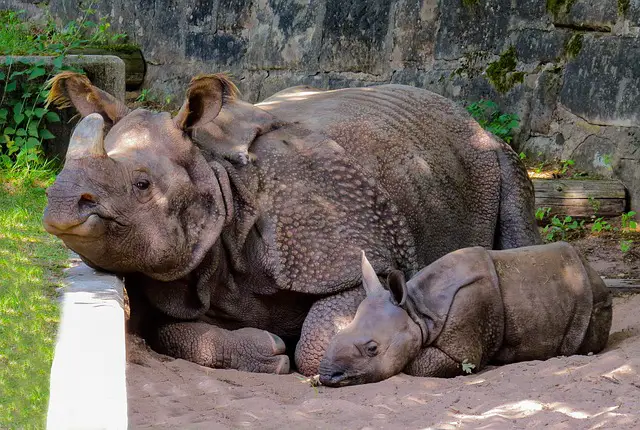
Rhino Adaptations
- The following are some of the major adaptations of rhinos:
-
Thick and Layered Skin
-
- All rhino species have thick and layered skin, which acts as natural armor and protects them from thorns and sharp grasses.
- Their skin is also folded at some parts of their body. After wallowing, the folds of their skin retain water or mud for a long time to keep them cool.
-
Thick and Padded Soles
-
- The feet of all rhino species have thick padded soles, which act as natural shock absorbers.
- It cushions their legs so they can easily walk and even run on rough surfaces.
-
Prehensile Upper Lip
-
- Some species of rhinos (Black, Sumatran, and Javan rhinos) are browsers and have well-adapted prehensile upper lips.
- Other species are grazers and have square-shaped mouths that are appropriate for grazing.
-
Keen Sense of Smell
- All species of rhinos have an extremely keen sense of smell. They mostly depend on their sense of smell and hearing as they have very weak eyesight.
- The olfactory passages (responsible for smell) of white rhinos are larger than their whole brain.
-
Acute Sense of Hearing
- All species of rhinos have an extremely acute sense of hearing.
- Their large ears can rotate automatically to pick up sounds.
- Like elephants, they use infrasonic frequencies to communicate that are below the hearing threshold of humans.
- Probably, they use infrasonic frequencies to communicate with each other in the dense vegetation of their habitat. The females may probably use it to show their breeding receptiveness to males.
Rhino Food Chain
- Rhinos are the primary consumers in the food chain.
- Sun is the overall source of energy.
- Plants are the producers that take energy from the sun and prepare their food through photosynthesis.
- Rhinos consume plant matter and are primary consumers.
- Rhinos do not have any natural predators. Sometimes, a pride of lions hunts an adult rhino, but it is very rare. Dung beetles, ticks, and fleas go on the skin of rhinos. Tick birds then eat ticks from their skin.
- The role of rhinos in the food chain is not significant, however, they play a vital role in keeping the ecosystem healthy.
Ecological Role of Rhino
- Rhinos are crucial for the environment.
- They are called the Keystone species, and sometimes the Umbrella species.
- They are mega-herbivores and reshape their surroundings.
- Their dung not only makes the soil fertile but also contains seeds that disperse and germinate.
- Through Geo-forming, they help to shape the entire ecosystem over time.

Population
-
White Rhino
-
- In 2001, the estimated population of southern white rhinos in the wild was 11,670, while there were 777 individuals worldwide in captivity.
- According to the IUCN, the estimated population of southern white rhinos in 2008 increased to 17,480 individuals.
- Northern white rhinos are now considered extinct in the wild. In 2005, there were only 4 individuals in the wild.
-
Black Rhino
-
- According to WWF, the current population of black rhinos is more than 5,000 individuals.
-
Sumatran Rhinos
-
- The currently surviving population of the Sumatran rhinos is fewer than 80 individuals.
-
Javan Rhinos
-
- The current population of Javan rhinos is about 58 to 61 individuals.
-
Indian Rhinos
-
- The total population of Indian rhinos was estimated as 2,575 individuals in 2006.
Why Are Rhinos Endangered
Reasons
The major reasons for the endangerment of rhinos are:
-
- Loss of Habitat is a serious threat to the survival of rhinos. Deforestation for woods, gaining land for agriculture, expanding cities, and other human activities shrank their habitat.
- Poaching is another extremely serious threat to their survival. Rhinos are illegally hunted for their horns and other body parts. In Asian markets, their horns are sold at tens of thousands of dollars per kilogram, which is a highly sought thing in traditional Chinese medicine.
Conservation status
-
- The conservation status of rhino species on the IUCN Red List is:
| Rhino Species | Conservation Status |
| White rhino | Near Threatened |
| Black rhino | Critically Endangered |
| Indian rhino | Vulnerable |
| Sumatran rhino | Critically Endangered |
| Javan rhino | Critically Endangered |
Rhino Predators
- There are no natural predators of rhinos in the wild because of their huge size.
- Big cats (tigers, lions, leopards, etc), crocodiles, African wild dogs, and hyena prey rhino calves.
- Humans are serious predators of rhinos and hunt them illegally for their body parts.
Fun Facts About Rhinos
- Rhinoceros is one of the living largest mammals on the land.
- Rhinos have one or two horns on the upper part of their snouts. Their horns are made up of keratin, a protein that also makes up human fingernails and hairs.
- The nostrils of white rhinos are the widest of all the land-based animals.
- The ears of the rhinoceros move independently to pick up and detect sounds.
- Like elephants, rhinos also communicate through infrasonic frequencies that are below the hearing threshold of humans.
- At birth, a rhino calf has a bodyweight from 40 to 65 kg, which is the weight range of about 13 to 20 years old humans.
- Adult rhinos do not have natural predators due to their huge size. They are rarely preyed on by a pride of lions or a group of other big cats.
- The thickly padded paws of rhinos are natural shock absorbers. It allows these huge-sized animals to walk, run, and climb easily on rough terrain.
- Rhinos and tick birds (also known as oxpeckers) have a symbiotic relationship. Tick birds eat ticks and other insects from the rhino skin and warn the rhinos through noises in case of danger. These birds also eat blood from their wounds and make it difficult to heal, however, they are still tolerated.
- The horns of rhinos are a highly sought commodity, which is used in traditional Chinese Medicine. It is sold at the price of tens of thousands of dollars per kg in Asian Markets.



